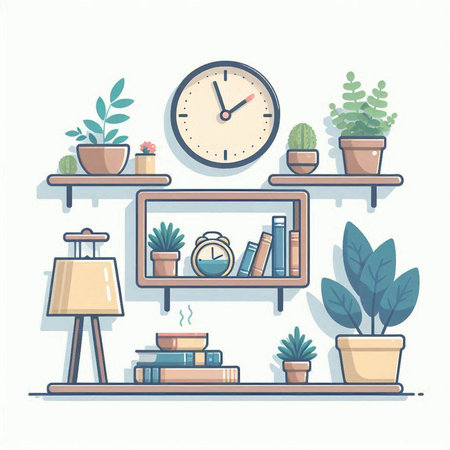Understanding the Value of Home Office Space in the UK
In recent years, the importance of having a dedicated home office space has become increasingly apparent throughout the UK. As more people embrace hybrid and remote working arrangements, British households are rethinking how they use their spare rooms and loft spaces. This shift reflects not just a response to changing work habits, but also a deeper transformation in how we value our homes as multi-functional environments. Traditionally, box rooms or attics might have served as guest bedrooms or storage areas; now, these underused corners are gaining new life as productive workspaces tailored to modern needs.
The unique nature of UK homes—often compact and with limited open-plan layouts—means that making the most of every square foot is essential. This has encouraged creative approaches to converting spare rooms and lofts into efficient offices that don’t just accommodate laptops, but also foster focus and well-being. The British love for clever storage solutions and orderly interiors plays a crucial role here, ensuring that even the smallest nook can be transformed into an inviting workspace. As lifestyles continue to evolve, the demand for thoughtfully designed home offices is set to remain a defining feature of domestic life across the UK.
Choosing the Right Spot: Spare Rooms vs. Loft Conversions
When planning to create a productive home office in the UK, one of the earliest and most important decisions is choosing between a spare bedroom or converting the loft space. Both options come with their own set of advantages and drawbacks, especially when considering factors that are highly relevant to British homes such as natural light, privacy, insulation, and accessibility. Below is a comparison to help you make an informed choice that suits your needs and lifestyle.
| Spare Room | Loft Conversion | |
|---|---|---|
| Natural Light | Typically has at least one window offering steady daylight; some rooms may face shaded gardens or neighbouring properties. | Often benefits from skylights or Velux windows, providing excellent overhead light but can be affected by roof orientation. |
| Privacy | Usually situated near family living spaces; noise from adjoining rooms may be an issue if not properly insulated. | Located away from main living areas, offering more seclusion and quiet, ideal for focused work or calls. |
| Insulation | Insulation standards depend on the age of the house; modern builds are typically better insulated than older Victorian or Edwardian homes. | May require significant investment in insulation to keep warm during UK winters and cool in summer; good opportunity to upgrade thermal performance. |
| Access | Easily accessible on main floors; no additional staircases required. | Might involve steep stairs or ladders; less suitable for those with mobility concerns or frequent visitors. |
Practical Considerations for British Homes
If you’re working from home long-term, comfort and practicality are key. Spare bedrooms are usually easier to convert with minimal disruption — think quick fresh paint, clever furniture choices, and some thoughtful storage solutions. However, they might not provide the same level of escape from household hustle and bustle as a well-insulated loft conversion. On the other hand, investing in your loft means creating a bespoke workspace tailored to your needs, but it often comes with higher costs and more extensive building works.
Storage & Organisation Tips
No matter which space you choose, maximising storage is essential in typical UK homes where square footage is precious. In a spare room, built-in wardrobes can double up as filing cabinets or supply closets. Lofts often benefit from custom shelving fitted into eaves and awkward nooks — making every inch count.
Summary Table: Which Option Fits Your Lifestyle?
| Lifestyle Need | Best Fit |
|---|---|
| Easy daily access & minimal renovation | Spare Room |
| Total privacy & custom design potential | Loft Conversion |
| Budget-friendly setup | Spare Room |
| Opportunity to add value to home | Loft Conversion |
Both spare rooms and lofts have their place in British homes; your final choice will likely depend on your daily routines, family dynamics, budget, and how much you want your workspace to blend in — or stand out — from everyday life.

3. Decluttering and Preparing the Space
Transforming a spare room or loft into a productive UK home office starts with a good clear-out. Years of accumulated belongings—old clothes, forgotten gadgets, or seasonal decorations—can quickly overwhelm your workspace if not addressed. Here’s a practical, step-by-step approach to decluttering and preparing your space, using clever UK storage solutions to create a tidy blank canvas for your new office.
Step 1: Sort and Assess
Begin by removing everything from the room or loft. Lay out your items and group them into three categories: keep, donate/sell, and dispose. Be honest about what you genuinely need, especially if you’re tight on space. Charity shops across the UK are always looking for donations, and apps like Gumtree can help you sell unwanted bits locally.
Step 2: Deep Clean and Inspect
With the space cleared, give it a thorough clean—dust skirting boards, hoover carpets, and wipe down surfaces. Check for dampness or insulation issues, especially in older British lofts. Now is also the time to freshen up walls with a coat of neutral paint to brighten the area and make it feel more spacious.
Step 3: Plan Storage Smartly
For those items you must keep nearby (like paperwork or equipment), opt for practical UK storage solutions that maximise every inch. Think under-bed drawers, floating shelves from B&Q, or fitted cupboards that blend seamlessly into alcoves. In loft spaces with sloping ceilings, bespoke shelving or stackable storage boxes from The Range can neatly tuck away clutter without eating into valuable floor space.
Step 4: Create Your Blank Canvas
Once decluttered and cleaned, arrange your remaining essentials in their new homes. Leave as much open space as possible—this will make your future office feel calm and inviting rather than cramped. Consider adding a rug or some plants to soften the look before you start moving in your desk and chair.
Your Ready Workspace Awaits
Tackling clutter might seem daunting at first, but taking it step by step makes all the difference. With a clear, organised room and clever local storage tricks up your sleeve, you’ll be perfectly set up to design an inspiring home office that truly works for your UK lifestyle.
Design Elements for a Productive Home Office
When transforming a spare room or loft into a home office, weaving in British design sensibilities can turn an ordinary space into a haven of productivity and comfort. The right mix of colour palettes, ergonomic furniture, and lighting—paired with signature homely touches—ensures your workspace is both inviting and efficient. Below, we explore the key design elements that help create a distinctly British yet highly functional home office environment.
Colour Palettes: Calm, Classic, and Reflective
British interiors often favour calming and classic hues that encourage focus without overwhelming the senses. Think soft greys, muted greens, warm neutrals, and even subtle blues—these shades reflect natural light beautifully, especially important in UK homes where daylight can be limited.
| Colour | Mood Created | Best Use |
|---|---|---|
| Sage Green | Calm, restful | Main walls or accent features |
| Pale Grey | Modern, neutral | Entire room backdrop |
| Navy Blue | Focused, cosy | Feature wall or built-in cabinetry |
| Cream/Off-white | Bright, spacious | Ceilings and trims |
Ergonomic Furniture: Comfort Meets Practicality
No home office is complete without supportive seating and an appropriately sized desk. Look for adjustable chairs with lumbar support—a must for those long hours at work. Compact desks with built-in storage suit smaller UK rooms or lofts perfectly, helping to keep clutter at bay.
Furniture Checklist for UK Home Offices:
- Height-adjustable chair with back support
- Compact desk (preferably with drawers)
- Shelving units or bookcases for vertical storage
- Multi-purpose storage ottoman or baskets for files and stationery
Lighting: Bright Ideas for British Homes
Good lighting is essential, particularly during darker months. Where possible, place your desk near a window to maximise natural daylight. Supplement with adjustable desk lamps or floor lights to prevent eye strain on gloomy afternoons. Opt for warm white LED bulbs to recreate the inviting glow of traditional British homes.
Types of Lighting:
- Task lighting: Focused illumination for reading or laptop work (e.g., anglepoise lamp)
- Ambient lighting: Ceiling fixtures or floor lamps for general brightness
- Accent lighting: Wall sconces or fairy lights to add warmth and character
Add Homely Comforts: The Finishing Touches
A productive workspace doesn’t have to feel sterile. Layer in soft textiles—a wool throw on your chair, a traditional patterned rug underfoot, or linen curtains—to bring that unmistakable sense of British cosiness. A framed print of your favourite local landscape or potted English ivy can inject personality and keep you feeling connected to home.
Quick Tips for Cosy Vibes:
- Add a teapot and mug tray for those essential tea breaks
- Incorporate a small radio tuned to BBC Radio 4 or Classic FM for gentle background sound
- Select organisers in classic materials like wood or wicker rather than plastic for a more homely aesthetic
The result? A home office that balances efficiency with comfort—perfectly tailored to both your work needs and quintessential British style.
5. Essential Tech and Connectivity Considerations
Transforming your spare room or loft into an effective UK home office isnt just about furniture and décor—the right technology and strong connectivity are vital for productivity. Begin by checking your broadband speed; many older British homes, especially those with thick walls or in rural areas, may struggle with weak Wi-Fi signals. Consider investing in a mesh Wi-Fi system or powerline adapters to ensure reliable coverage throughout your workspace. When it comes to electrical needs, be mindful that UK plugs and sockets (Type G) can differ from what you find elsewhere. If you’re working in a converted loft, you might need extra sockets installed by a qualified electrician to meet both safety standards and daily requirements for charging devices, running computers, and powering lighting.
Organising Cables for Clarity
Cable management is crucial in smaller spaces typical of UK homes. Use cable trays, under-desk organisers, or even classic cable ties to keep wires tidy and out of sight. In a loft conversion where floorspace is at a premium, wall-mounted shelves can help store routers or external drives off your desk, maintaining an uncluttered feel. For easy access to power without trailing leads across the room, look for UK extension leads with surge protection—ideally ones that come with USB ports for added flexibility.
Securing Equipment in Multi-Use Spaces
If your home office also serves another purpose, such as a guest bedroom or hobby area, opt for portable tech solutions. Wireless printers, compact monitors, and laptop stands can be stowed away when not needed. For additional security in shared households or family environments, consider lockable storage boxes for sensitive electronics or documents.
Final Touches: Streamlining Your Digital Workspace
A productive home office relies on both physical and digital organisation. Take time to set up cloud storage and regular data backups using reputable UK-based providers if possible. This safeguards your work against unexpected outages and keeps everything accessible whether you’re working from home or occasionally from a local café. By paying attention to these essential tech and connectivity details, your converted room will truly serve as a streamlined, efficient workspace tailored to the unique demands of the UK home environment.
6. Staying Organised: Storage Solutions for Small British Homes
Transforming a spare room or loft into a productive home office in the UK often means working with limited space, especially in period properties and modern flats. To maximise your office’s potential and maintain that quintessential British orderliness, clever storage solutions are essential. Here are some practical ideas for filing, shelving, and keeping your workspace tidy and clutter-free.
Smart Shelving to Maximise Vertical Space
When floor space is tight, think vertically. Fitted shelves above desks or along alcoves make good use of awkward corners and high ceilings typical in many British homes. Floating shelves provide accessible storage without bulky furniture, while ladder shelves lend a contemporary touch. Opt for adjustable shelving to adapt as your needs change.
Compact Filing Systems
Even with digital documents, paperwork has a way of piling up. Invest in compact filing cabinets or under-desk pedestal drawers to keep important documents organised and out of sight. For smaller spaces, a wall-mounted file organiser or magazine rack can hold post, notebooks, and ongoing projects without taking up valuable floor area.
Multi-Functional Furniture
In true British fashion, multi-purpose furniture is both practical and stylish. Consider desks with built-in drawers or ottomans that double as storage. Fold-away desks are brilliant for box rooms or multi-use spaces—simply close them up at the end of the day to reclaim your room for leisure or guests.
Baskets, Bins, and Decorative Boxes
No one does charming organisation quite like the Brits. Woven baskets, patterned storage boxes, and vintage tins not only keep supplies tidy but also add personality to your office. Store cables, stationery, or tech accessories in labelled containers on shelves or under tables to keep surfaces clear.
Embracing Minimalism
The British love for order extends to a “less is more” approach. Regularly declutter by donating unused items and recycling old paperwork. Keep only what you need within arm’s reach; everything else can be stored away or archived elsewhere in the home.
The Finishing Touch: A Place for Everything
The hallmark of an organised British home office is having a designated spot for each item. Use drawer dividers for small bits and bobs, label files clearly, and make tidying up part of your daily routine. With thoughtful storage solutions tailored to British homes, your converted spare room or loft will remain both efficient and inviting—a true reflection of practical UK living.
7. Personal Touches and Work-Life Balance
Turning a spare room or loft into a home office isn’t just about function—it’s about creating a space where you actually enjoy spending your time. Injecting personality through local British art, cherished memorabilia, or even a few hardy houseplants can make all the difference. A vintage railway poster from your favourite seaside town, a framed photo from last summer’s Lake District walk, or a quirky ceramic mug from a Cornwall market adds warmth and identity to your workspace. These details not only brighten up the daily grind but also help keep you connected to what you love about your home and region.
Of course, working from home in the UK often means blurring the boundaries between professional and personal life, especially when your ‘commute’ is just up the stairs. To avoid feeling as if you never leave the office, try some simple mental tricks: at the end of each workday, tidy away papers and close your laptop—perhaps even pop them in a basket or cupboard if you’re short on space. This physical act signals to your brain that it’s time to switch off.
If your home office doubles as a guest room or hobby nook, use clever storage like under-bed boxes or wall-mounted shelves to keep work materials out of sight after hours. You might also introduce a gentle ritual—brew a proper cup of tea when you finish work, play your favourite playlist, or step out for a brisk walk around the block (umbrella at the ready!). These small habits help reinforce the boundary between work and leisure.
By blending practical organisation with personal style, you’ll create not only an efficient workspace but also one that feels truly yours—a place that supports productivity during office hours and relaxation once the workday is done.

